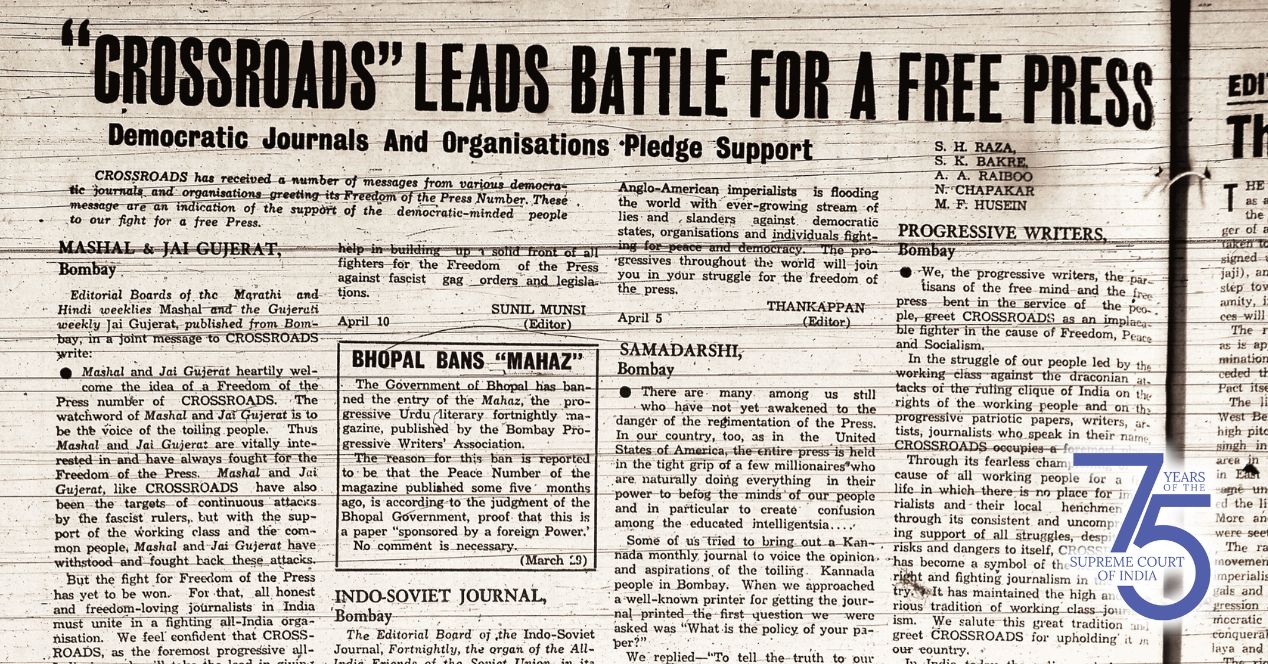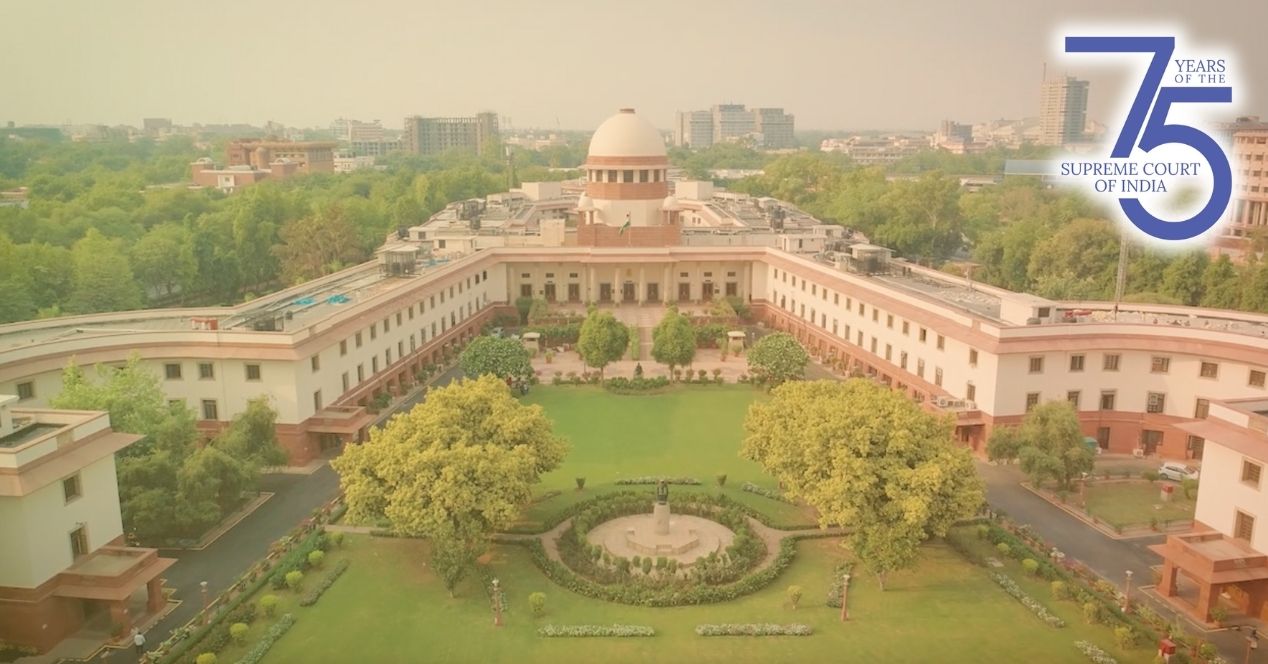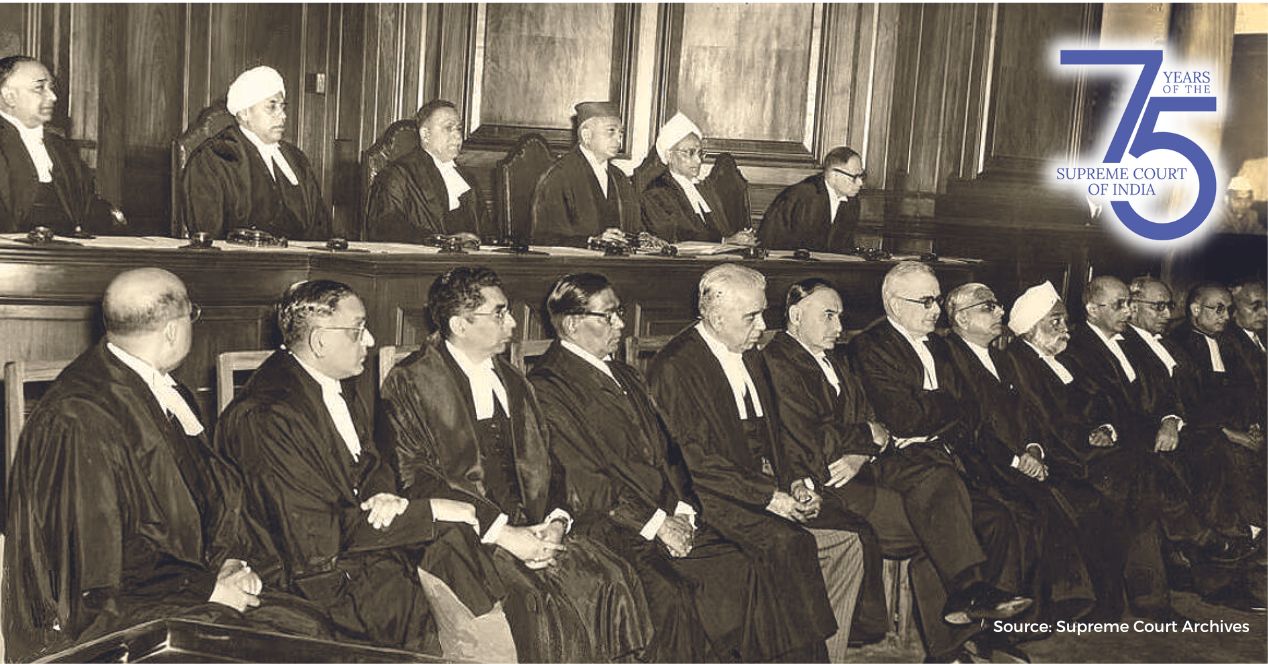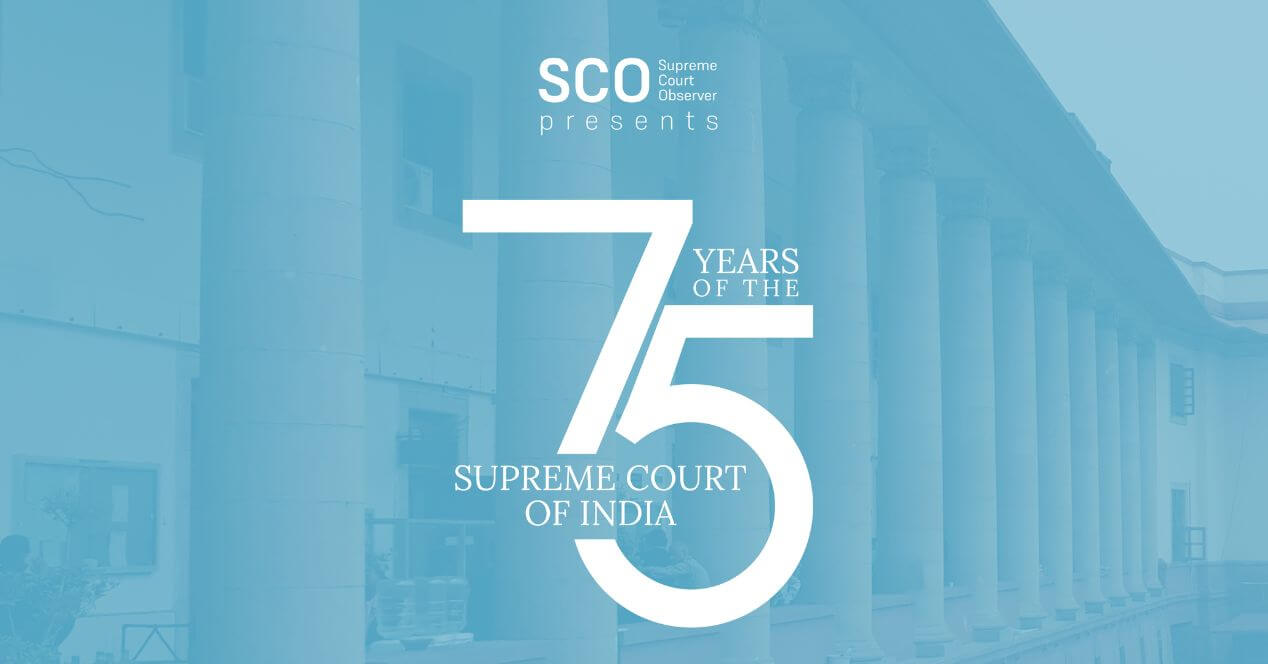Trial by Cinema
How a handful of films have challenged the onscreen notion of Indian judiciary as an infallible arbiter of justice
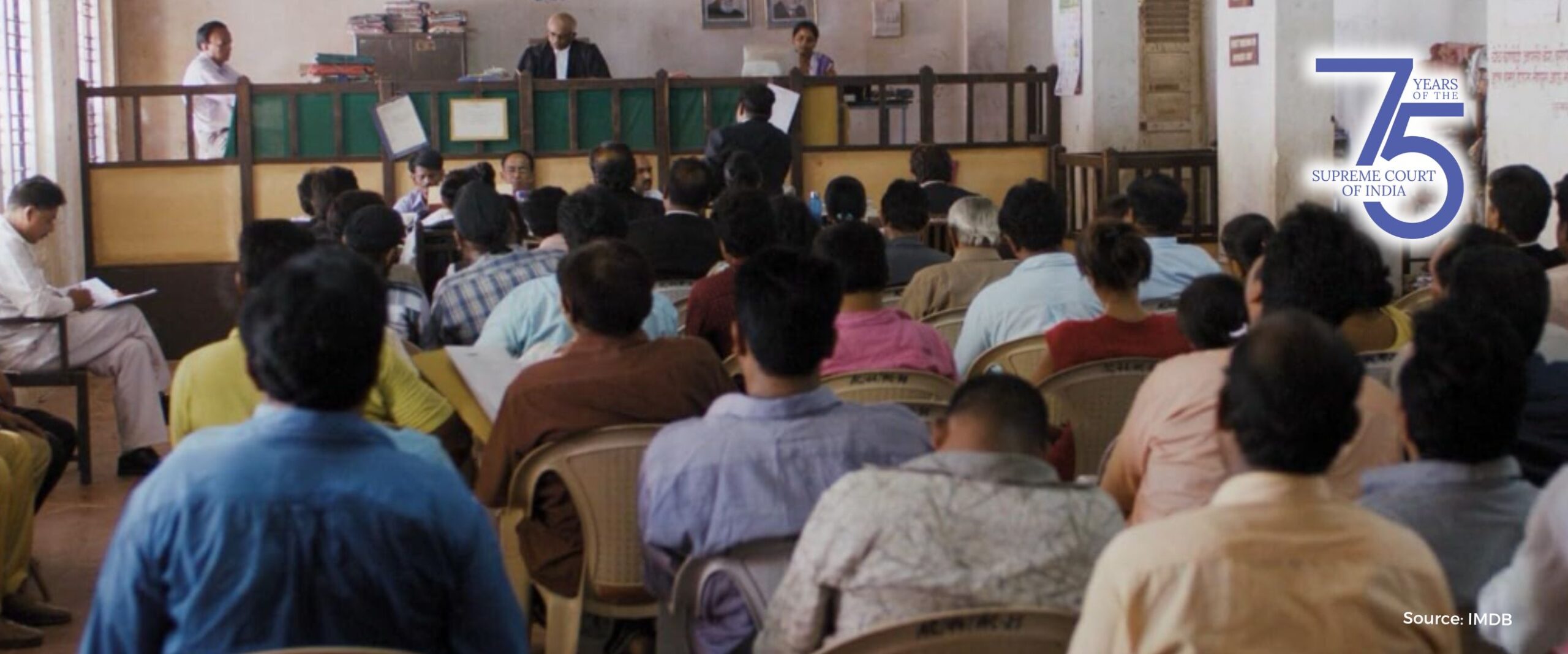
As the Supreme Court approaches its 75th anniversary, we asked one of India’s finest film critics to unpack the storied relationship between our courts and cinema. Out came a piece of incisive commentary. Anna M.M. Vetticad asserts that the portrayal of the judiciary in Indian films extends beyond mere entertainment—it serves as a critical mirror reflecting societal attitudes toward justice. Her essay poses a crucial question for all those who seek a deeper understanding of reality through art: why have only a handful of Indian films engaged with the actual realities of our courtrooms?
Vetticad traces the evolution from idealized courtroom dramas to more realistic, often critical depictions, such as in Chaitanya Tamhane’s “Court,” revealing how a section of Indian cinema has evolved in its portrayal of the legal system while much of the cinematic output remains rooted in fantasy. At this particularly poignant moment for Indian democracy, her essay provides a fresh perspective on how the arts engage with and critique the nation’s record on justice.
– Curator’s note by Snigdha Poonam
As the Supreme Court’s 75th birthday draws near, Indian cinema provides a measure of the public’s engagement with the judiciary through the repeated appearance of courtrooms in our films.
It so happens that an anniversary significant to cinephiles is also approaching: 10 years ago, one of the finest Indian courtroom sagas had its world premiere. Written and directed by Chaitanya Tamhane, the Marathi-English-Hindi-Gujarati Court was screened in September 2014 at the Venice International Film Festival.
A comparison between the multiple award-winning, globally acclaimed Court and a selection of landmark courtroom-based Indian hits over the last decade reveals how sections of Indian cinema have evolved in their portrayal of the justice system.
If the wheels of justice ran as they ought to, then Brihanmumbai Municipal Corporation (BMC) officials would have been jailed in Court.
This film, however, is rooted in reality, not fantasy. So, in the story, when a contract worker dies of asphyxiation in a sewer, the police ignore the BMC’s neglect, and hold a Dalit activist-singer, Narayan Kamble, culpable for inciting him to discard safety gear. They insist that the poor man heard Kamble sing a song asserting that “giving up your life is the one and only rational solution for certain sections of the society (sic) to gain dignity and respect”. Applying a farcical, twisted logic to this statement of resistance, rage and despair, they arrest Kamble and try him for abetment of suicide.
This bizarre inversion of justice playing out in a Mumbai trial court is primed for satire or melodrama. Tamhane chose a hyper-realistic, non-satirical route instead.
Court comes from a long line of Indian films that have featured the judiciary since the early days of cinema. Ashish Rajadhyaksha and Paul Willemen’s Encyclopedia of Indian Cinema cites a production from as far back as 1927—Manilal Joshi’s silent film Nanand Bhojai, a.k.a. The Victim of Society in which “A greedy brother forces his educated sister to marry a rich old man. She rebels, goes to court and succeeds in preventing the marriage.”
In the century since Nanand Bhojai, commercial Indian cinema has remained inclined to show the judiciary righting various wrongs. Alongside this, filmmakers have glamourised courts and dramatised their functioning.
The courtroom in star-led commerce-driven films has traditionally been a hallowed place that the public entered with innocent optimism.
Secure within those walls, ordinary folk would give impassioned speeches about their sufferings, societal ills and the failings of those in power. Flamboyant lawyers may have belted out furious monologues about hapless people being given “tareekh par tareekh” (date after date) instead of verdicts (Damini / Hindi, 1993), yet, justice would ultimately be served in most of those films.
Court’s defining characteristics thus make it uncommon. First, the extent of authenticity in its portrayal of legal processes and the court itself—not 100 percent accurate, but close. Second, the pessimism that is fundamental to its realism.
A song performed by Kamble (played by the late Dalit activist Vira Sathidar) goes so far as to refer to the State, with biting sarcasm, as the “Lord” that’s been so kind as to try him in court instead of violently silencing him as is its wont. He clearly sees through the pretence of the trial in this starless, no-frills film.
Notwithstanding Court’s pathbreaking realism, some of the biggest courtroom blockbusters of the decade since its release continued to radiate confidence in the judiciary. However, some films that came out during this crucial phase stood out for depictions more faithful to the drudgery of real-life legal proceedings and the drabness of courtrooms than before. Both qualities are abundantly on display in three works widely discussed across India in this period: Pink (Hindi, 2016) directed by Aniruddha Roy Chowdhury, T.J. Gnanavel’s Jai Bhim (Tamil, 2021), and Ratheesh Balakrishnan Poduval’s Nna Thaan Case Kodu (Then Sue Me / Malayalam, 2022).
The differences between this trio and Court spring from their intent.
Firstly, escapism is an essential attribute of commercial Indian cinema. That explains why cash-rich producers prefer backing the likes of Pink, Jai Bhim and Nna Thaan Case Kodu where the marginalised get justice against all odds. This is also an important factor in the virtual monopoly of lower courts, rather than the Supreme Court, in mainstream films. The implication is that a country beset by corruption and inequity is redeemed by our courts, assuring the public of a happily ever after at the very first rung of the judicial hierarchy.
Court, on the other hand, rips the mask off a legal system that, from the bottom up, further oppresses the socially oppressed.
Second, films headlined by major stars usually operate in the service of their central artist’s stardom. The more larger-than-life the actor, the more they aim to be conflated with the heroic characters they play. This is why, in legal dramas, such stars prefer to be cast as lawyers, not judges. Because the lawyer’s job lends itself to greater flair and bombast.
Judges have sometimes been interesting characters, but rarely are they among a film’s primary players. Raj Kapoor’s Awaara (Hindi, 1951) was an iconic deviation from the norm. Awaara played on the idea of class/caste pride through the character of a lawyer-turned-judge, Raghunath (Prithviraj Kapoor), who believes that good people are born to good people while criminal parents spawn criminals. In a telling twist of fate, Raghunath’s estranged son grows up to be a thief.
One of the most compelling screen judges of this decade appeared in the Tamil film Gargi (2022) directed by Gautham Ramachandran. The transgender actor Sudha S. played a transgender judge who shuts down prejudice in the courtroom in Gargi. Even though the character had a supporting role in the story, the portrayal marked a milestone in LGBT-plus representation in Indian cinema.
Court itself dwells on the conservatism of the judge hearing Kamble’s case. However, in commercial cinema, the spotlight is usually on lawyers. Justice in these films is not delivered by the judiciary as much as snatched from it or coaxed out by a clever, forceful lawyer played by a top-ranked—usually male—star. This character, warring for virtuous causes and crusading for common folks, is designed to rub off on the star’s image and further gigantify him. Towards this end, the lawyer remains the colossus on the scene even if his clients, the survivors of a crime, are given agency.
In the universe inhabited by these male stars, the courtroom is just another sporting arena. While in other films they physically wrestle muscular villains, here they cross swords and words with opposing lawyers and criminals.
This analogy is amply illustrated by Pink. In this film, three women fight for justice when one of them is sexually assaulted by a politician’s nephew. The police collude with the perpetrator and arrest the survivor for striking him, although she acted in self-defence. While the women of Pink were given screen time and substance, the winning shot—the punchline in court, the declaration that “no means no” in sexual relations—was assigned to the male superstar, Amitabh Bachchan, playing their lawyer Deepak Sehgal. The film was put together and marketed in such a way as to ensure that the ultimate takeaway from it was Bachchan’s courtroom performance.
Pink was moving nevertheless, because it achieved a tenuous balance between highlighting Bachchan and ensuring that his character did not eclipse the sexual assault.
That said, Sehgal even badgers his client (Taapsee Pannu) on the witness stand about her sexual history. This intrusive, aggressive interrogation was evidently written for dramatic effect. The fact that it was presented as commendable legal strategy suggested a disregard for a vital reason why real-world women avoid filing police complaints about sexual abuse: the fear of being humiliated in court by defence lawyers.
In contrast, the script of the vastly superior Jai Bhim did not allow Suriya as the lawyer Chandru to patronise or bully his client, the feisty Sengeni (Lijomol Jose). Jai Bhim is about this impoverished tribal woman who refuses to stay quiet when her husband is tortured and killed in police custody. Though Chandru was subtly heroised—with a grand entry befitting a conventional leading man, and camerawork foregrounding him over Sengeni in the finale—Jai Bhim offset that by giving her depth and space.
In a majority of such films, the lawyer has been an ally from a dominant social group: a man championing women’s rights in Pink, an apparently upper-caste man advocating for a tribal woman in Jai Bhim. Don’t misread this analysis: allies should certainly be immortalised. The issue here is that mainstream Indian cinema prioritises allies from privileged communities over activists and achievers among the oppressed.
Nna Thaan Case Kodu rejected this formula. The marquee name in its credits, Kunchacko Boban, did not play a showy lawyer defending an underprivileged client. Instead he was cast as Rajeevan, an indigent labourer who, when charged with a crime he did not commit, argues his own case in court. Rajeevan, a reformed thief, blames a minister in Kerala for a chain of events that lead to him being falsely accused. So, he sues the minister.
Kunchacko’s Everyman image and willingness to play the David in a David-v-Goliath battle perfectly suited a narrative that abjured high-falutin sermons, using humour instead to affirm that a citizen who believes in the judiciary could potentially fell the mighty.
In its choice of theme, Court is the antithesis of such mainstream productions set in courtrooms. The prosecution of an activist from a persecuted community for a crime committed by authorities who escape scrutiny is a metaphor for present-day India—an India in which the judiciary is weaponised against the downtrodden and dissidents.
The film’s cynicism is a pronounced departure from the idealism with which the foundations of Independent India were laid, on the assumption that governments and courts would protect subjugated peoples.
The most insightful characterisation in Court is that of the public prosecutor, Nutan (Geetanjali Kulkarni), a diligent lower-middle-class woman whose unexceptional appearance belies the damage she does with her unquestioning fixation on the letter rather than spirit of the law. Early on, when the defence counsel argues that bail is being denied to Kamble under “a Victorian law dating back to 1876” and urges the judge to use his discretion “about its relevance in a post-colonial country,” Nutan’s objection is: “It is the law. It is there.” She is an educational contemporary example of what the Nazi-era German-American historian Hannah Arendt described as “the banality of evil”.
Kamble’s lawyer Vinay Vora (Vivek Gomber) may seem like Court’s point of commonality with Pink and Jai Bhim, but he is not. Vora is affluent and presumably upper caste, but contrary to trends in mainstream cinema, the script positions him as Kamble’s supporter not hero. If anyone in Court breathes fire, it is Kamble with his defiant answers to Nutan and assertive songs, as well as the dead worker’s wife, whose unflinching testimony in the witness box exposes the systemic apathy that murdered her husband.
Kamble’s all-consuming fervour is echoed by a lawyer in another starkly realistic film: Shalini (Renu Sounder), the Dalit lead in Vidhu Vincent’s Manhole (Malayalam, 2016). This is an account of the lives of people employed for manual scavenging (the disposal of human excrement by hand) and ostracised because of their occupation.
In a chilling passage harking back to the gaslighting in Court, a government lawyer in Manhole claims before the Kerala State Human Rights Commission that Shalini’s friend could not possibly have died due to his work as a manual scavenger, given that the practice is banned (note: manual scavenging has been prohibited by legislation in India since 1993, and the Supreme Court has since ordered the Central and state governments to enforce the ban). Shalini’s demand for compensation to his family is vehemently contested since the very existence of a manual scavenger is an indictment of the government and therefore is denied.
Although Shalini joins the system to fight it, Manhole’s climax mirrors Court’s distrust of the establishment.
The Supreme Court’s upcoming diamond jubilee has been marked by celebrations. Tempering those celebrations with introspection would serve Indian democracy well. Because if cinema is a barometer of public concerns, then it is worth reflecting on why realistic Indian cinema tends to have low expectations from courts and quasi-judicial bodies. After all, if justice is dispensed usually in films that intrinsically call for a suspension of disbelief, this implies a bitter cynicism on the part of filmmakers and audiences—a troubling belief among the citizenry that justice is an elusive dream outside the fictional realm.
Anna M.M. Vetticad is an award-winning journalist and author of The Adventures of an Intrepid Film Critic. She specialises in the intersection of cinema with feminism and other socio-political concerns. She can be reached on Twitter: @annavetticad, Instagram: @annammvetticad, Facebook: AnnaMMVetticadOfficial

